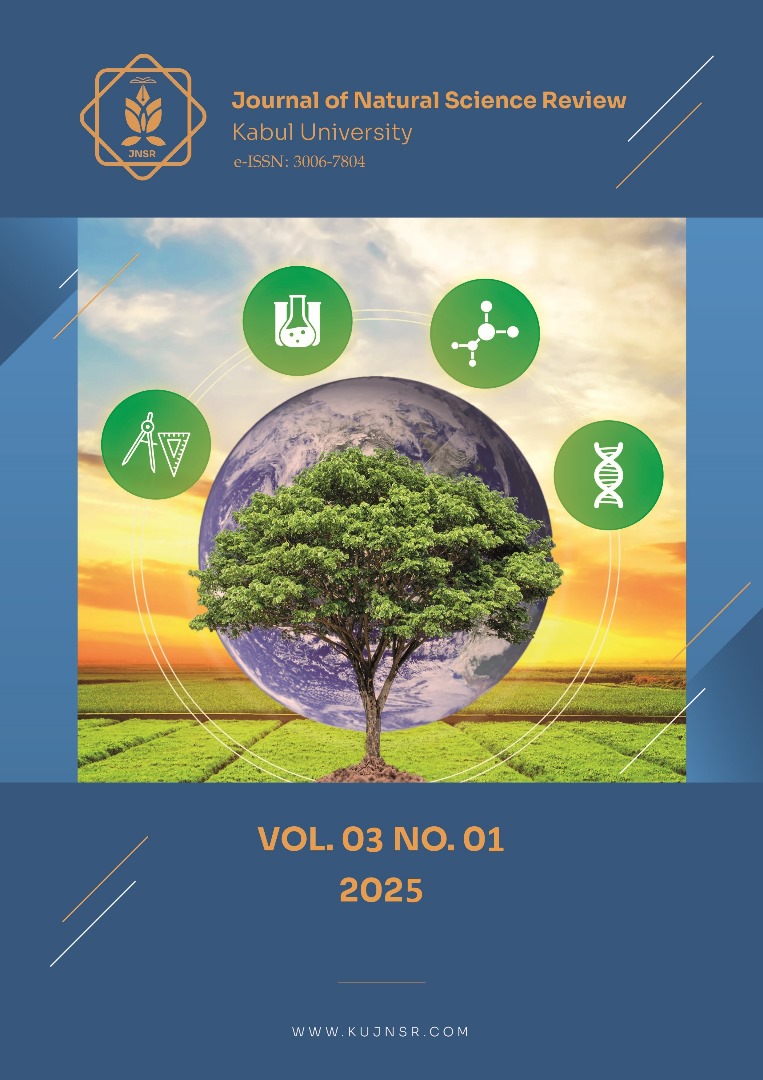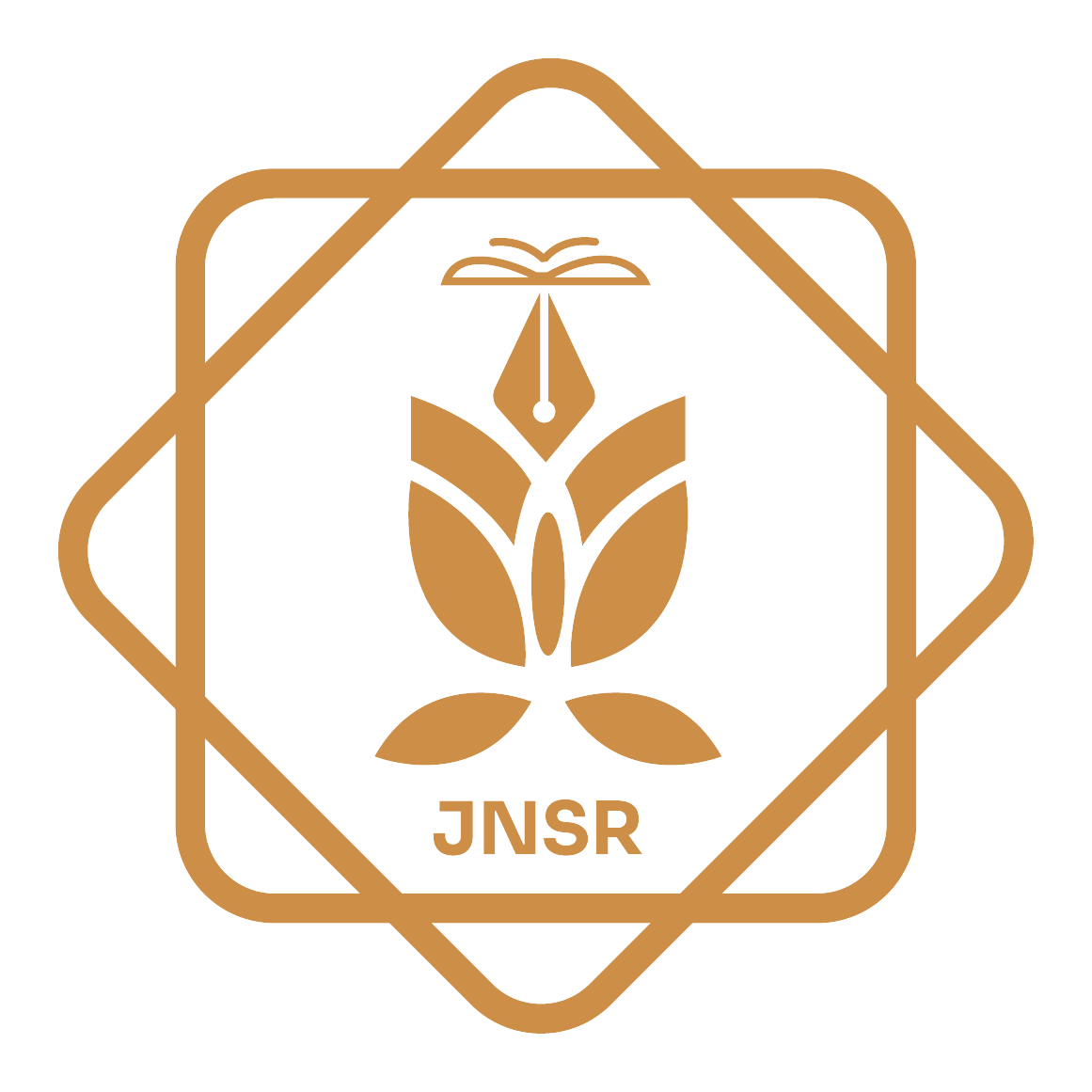Analysis of Vegetation Change Trends Using Satellite Data and Remote Sensing Techniques (Case Study: BAGRAM-Afghanistan)
DOI:
https://doi.org/10.62810/jnsr.v3i1.158Keywords:
Agriculture Species, Classification, Garden Species, GIS, Remote SensingAbstract
Garden and agricultural species are closely related phenomena mainly observed in different regions of the world. Wherever there is agriculture, there are bound to be both fruitful and non-fruitful trees. Bagram district is one of the districts of Parwan province, where most of the people of this district are engaged in agriculture for their livelihood. The main objective of this research is to use satellite data, and an effort was made to extract the areas under plant cover and separate garden and crop species. The normalized vegetation cover index was used to obtain the areas covered by vegetation. All the areas covered by vegetation were extracted, and then the supervised maximum likelihood classification method was used to separate garden and agricultural species from each other. This research applied the vegetation index to Sentinel-2 imagery from 2018 and 2023, followed by supervised classification on the same datasets. Finally, the result was that the area of agricultural land in 2018 was equal to 92 square kilometres, but it reached 100 square kilometres in 2023. Also, the land area of gardens was 15.92 square kilometres in 2018. However, by 2023, it reached 27 square kilometres, and the area of agricultural lands and gardens in the Bagram district has increased by almost 20 square kilometres from 2018 to 2023.
Downloads
References
Afzali, R., Dastjerdi, H. K., Khoshmanzareh, S. Z., Zaki, Y., & Dero, Q. Y. (2022). Monitoring of water resources and vegetation in the Helmand Basin using satellite image time-series and border hydro-political challenges. Water Policy, 24(8), 1223–1246. https://doi.org/10.2166/WP.2022.280 DOI: https://doi.org/10.2166/wp.2022.280
Amiri, R., & Hedayat, S. J. (2024). classification of Garden and agriculture species using satellite data and remote sensing technique (case study: Bagram- Afghanistan). Parwan University.
Ebrahimi-Khusfi, M. (2023). Analysis of Changes in the Area of Hamoon Wetlands and other Water Bodies in Sistan Region using Satellite Images. Geography and Development, 21(71), 139–165. https://doi.org/10.22111/GDIJ.2023.7598
Gao, L., Wang, X., Johnson, B. A., Tian, Q., Wang, Y., Verrelst, J., Mu, X., & Gu, X. (2020). Remote sensing algorithms for estimation of fractional vegetation cover using pure vegetation index values: A review. ISPRS Journal of Photogrammetry and Remote Sensing, 159, 364–377. https://doi.org/10.1016/J.ISPRSJPRS.2019.11.018 DOI: https://doi.org/10.1016/j.isprsjprs.2019.11.018
Gilabert, M. A., González-Piqueras, J., García-Haro, F. J., & Meliá, J. (2002). A generalized soil-adjusted vegetation index. Remote Sensing of Environment, 82(2–3), 303–310. https://doi.org/10.1016/S0034-4257(02)00048-2 DOI: https://doi.org/10.1016/S0034-4257(02)00048-2
Hedayat, S. J., Ebrahimi-Khosfi, M., Omidvar, K., & Sharifi Pichoon, M. (2024). Investigating Factors Affecting Changes in Surface and Ground Water Resources Using Satellite Products (Case Study: Kabul-Afghanistan). Journal of Water and Sustainable Development, 11(1), 13–24. https://doi.org/10.22067/jwsd.v11i1.2312-1291
Hedayat, S. J., & Yosufi, M. K. (2024). Assessing Precipitation Impact on Vegetation Using Satellite Data and Remote Sensing Techniques: A Case Study of Yakawalang-Afghanistan. Journal of Natural Science Review , 2(3), 121–137. https://doi.org/10.62810/JNSR.V2I3.76 DOI: https://doi.org/10.62810/jnsr.v2i3.76
Liu, C., Li, W., Wang, W., Zhou, H., Liang, T., Hou, F., Xu, J., & Xue, P. (2021). Quantitative spatial analysis of vegetation dynamics and potential driving factors in a typical alpine region on the northeastern Tibetan Plateau using the Google Earth Engine. Catena, 206. https://doi.org/10.1016/j.catena.2021.105500 DOI: https://doi.org/10.1016/j.catena.2021.105500
Meili, N., Acero, J. A., Peleg, N., Manoli, G., Burlando, P., & Fatichi, S. (2021). Vegetation cover and plant-trait effects on outdoor thermal comfort in a tropical city. Building and Environment, 195, 107733. https://doi.org/10.1016/J.BUILDENV.2021.107733 DOI: https://doi.org/10.1016/j.buildenv.2021.107733
Pettorelli, N. (2013). The Normalized Difference Vegetation Index. The Normalized Difference Vegetation Index, 1–208. https://doi.org/10.1093/ACPROF:OSOBL/9780199693160.001.0001 DOI: https://doi.org/10.1093/acprof:osobl/9780199693160.001.0001
Running, S. W., Loveland, T. R., Pierce, L. L., Nemani, R. R., & Hunt, E. R. (1995). A remote sensing based vegetation classification logic for global land cover analysis. Remote Sensing of Environment, 51(1), 39–48. https://doi.org/10.1016/0034-4257(94)00063-S DOI: https://doi.org/10.1016/0034-4257(94)00063-S
safi, S. A. J., ÇAM, M. A., Habibi, E., & YILMAZ, Ö. F. (2024). Effects of Climate Change on Animal Production. Journal of Natural Science Review , 2(2), 1–14. https://doi.org/10.62810/JNSR.V2I2.30 DOI: https://doi.org/10.62810/jnsr.v2i2.30
Salmi, T., Maatta, A., Anttila, P., Ruoho-Airola, T., & Amnell, T. (2002). Detecting Trends of Annual Values of Atmospheric Pollutants by the Mann-Kendall Test and Sen’s Solpe Estimates the Excel Template Application MAKESENS. Finnish Meteorological Institute, Air Quality Research, 35. https://www.researchgate.net/publication/259356944_Detecting_Trends_of_Annual_Values_of_Atmospheric_Pollutants_by_the_Mann-Kendall_Test_and_Sen’s_Solpe_Estimates_the_Excel_Template_Application_MAKESENS
Tenreiro, T. R., García-Vila, M., Gómez, J. A., Jiménez-Berni, J. A., & Fereres, E. (2021). Using NDVI for the assessment of canopy cover in agricultural crops within modelling research. Computers and Electronics in Agriculture, 182. https://doi.org/10.1016/j.compag.2021.106038 DOI: https://doi.org/10.1016/j.compag.2021.106038
Wheater, H., & Evans, E. (2009). Land use, water management and future flood risk. Land Use Policy, 26(SUPPL. 1), S251–S264. https://doi.org/10.1016/J.LANDUSEPOL.2009.08.019 DOI: https://doi.org/10.1016/j.landusepol.2009.08.019
Xue, J., & Su, B. (2017). Significant Remote Sensing Vegetation Indices: A Review of Developments and Applications. Journal of Sensors, 2017(1), 1353691. https://doi.org/10.1155/2017/1353691 DOI: https://doi.org/10.1155/2017/1353691
Downloads
Published
How to Cite
Issue
Section
License
Copyright (c) 2025 Sayed Jawad Hedayat, Mohammad Kazem Yosufi

This work is licensed under a Creative Commons Attribution-NonCommercial 4.0 International License.



























